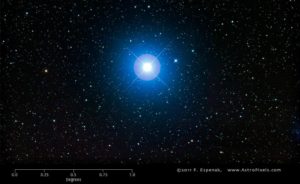Stars are massive spheres of gases held together by gravity. The nearest star we have is the Sun at the center of the solar system. Its about 150000000 km away from us but still we can feel its hot temperature. Where there are as many stars in the universe as much as grains of sand earth has. Where some stars are smaller in size where some are so Big that our Sun will look like a tiny dot in front of them. The below is the list of top 10 largest stars known in the universe.
10 – Pollux
An orange giant star which lies around 34 light years from Earth, it is around nine times larger than the sun with twice its mass,it’s radius is 5,564,000 km. Pollux is the brightest star in the Gemini constellation. Surface temperature is approximately 4,865 K.
9 – Arcturus
Arcturus is a red giant star which is the brightest star in the constellation Botes (the Herdsman). It is the fourth brightest star in the night sky, after Sirius, Canopus and Alpha Centauri. The distance from Earth is about 36.8 light year. Arcturus is around 25 times larger than the sun, radius is about 17,870,000 km. Arcturus is around 7.1 billion years old and has likely begun fusing helium into oxygen and carbon in its core. Surface temperature is approximately 4,290 K. It will expand further after its helium supply is exhausted, slough off its outer shell and become a white dwarf inside a planetary nebula.
8 – Aldebaran
Aldebaran is an orange giant star located about 65 light years away in the constellation of Taurus. Aldebaran is around 44,2 times larger than the Sun, the radius is about 30,740,000 km . Surface temperature is approximately 3,910 K. Measured it as 65.1 light years away. Aldebaran shines with 425 times the Sun’s luminosity.
7 –Rigel
Rigel is the brightest star in the constellation Orion and the seventh brightest star in the night sky. Around 12,000 times as luminous as the Sun. Rigel is most visible in winter evenings in the northern hemisphere and summer in the southern. The distance from Earth is about 860 light year. It is around 78 times larger than the Sun, the radius is approximately 54,250,000 km. Surface temperature is approximately 11,000 K.
6 – Antares
Antares is the brightest star in the constellation Scorpius, it has around 850 times the radius of the Sun and 12 time massive than the Sun, if it was placed in the center of our solar system it would reach beyond the orbit of Mars. The distance from Earth is about 550 light year. It is around 57,500 times brighter than the Sun. Around 12 million years old Antares is already nearing the end of its lifespan and is expected to explode as a supernova in the next million years. Low mass stars such as our sun exist in their main sequence for several billion years. Surface temperature is approximately 18,500 K.
5 –Betelgeuse
Betelgeuse is a red supergiant which is the ninth brightest star (the brightest star in the sky is the Sirius) in the night sky and second brightest in the constellation of Orion. This star is 640 light years away from Earth with 20 times more mass than the Sun. Betelgeuse radius is about 820,700,000 km. Red supergaints that have the same age as Betelguese are expected to end its life soon. It’s radius excess 1200 times that of our Sun. Surface temperature is approximately 3,600 K.
4 – Mu Cephei
Mu Cephei is a red supergiant star in the constellation Cepheus. It is one of the largest and most luminous star known in the Milky Way. The distance to Mu Cephei is approximately 6000 light year. With 20 times more mass than the Sun it has 1,420 times more radius than the Sun, about 988,036,000 km. Surface temperature is approximately 3,690 K. Mu Cephei is nearing death. It has begun to fuse helium into carbon, whereas a main sequence star fuses hydrogen into helium. The helium-carbon cycle shows that Mu Cephei is in the last phase of its life and may explode as a supernova. Around 38,000 times as luminous as the Sun.
3 – VV Cephei
Located in the constellation Cepheus, VV Cephei is about 4,900 light-years from Earth.VV Cephei, also known as HD 208816. Surface temperature is approximately 3,600 K. This red hypergiant star is estimated to be between 1,050 and 1,100 times the radius of the Sun.
2 – VY Canis Majoris
VY Canis Majoris is a red hypergiant in the constellation Canis Major. It is the largest known stars by radius and also one of the most luminous of its type. It’s radius is approximately 1,540 times bigger than the Sun and 25 times more mass then Sun. It is around 270,000 times brighter than the Sun. With this size it would reach nearly to the orbit of Saturn if placed in our solar system. This star is 4,900 light years away from Earth
1 – Stephenson 2-18

The largest known star in the universe, Stephenson 2-18 or RSGC2-18, is an incredibly impressive celestial body. It has been estimated to have a diameter of 1,700 solar diameters, making it 1,000 times larger than our Sun. This star is located in the constellation Aquila, which is approximately 7,500 light-years from Earth. The sheer size of Stephenson 2-18 is mind-boggling. It is so large that it would take the light from the Sun 7.5 years to travel across it. To put it into perspective, if we were to replace our Sun with the Stephenson 2-18, it would be so large that it would reach the orbit of Saturn.
What’s even more remarkable is that this star is still actively burning. Despite its immense size, it is still able to generate energy and power its own star system. This is a testament to the power of nature and the resilience of the laws of physics, as Stephenson 2-18 defies all of our expectations for the size and power of a star.

















